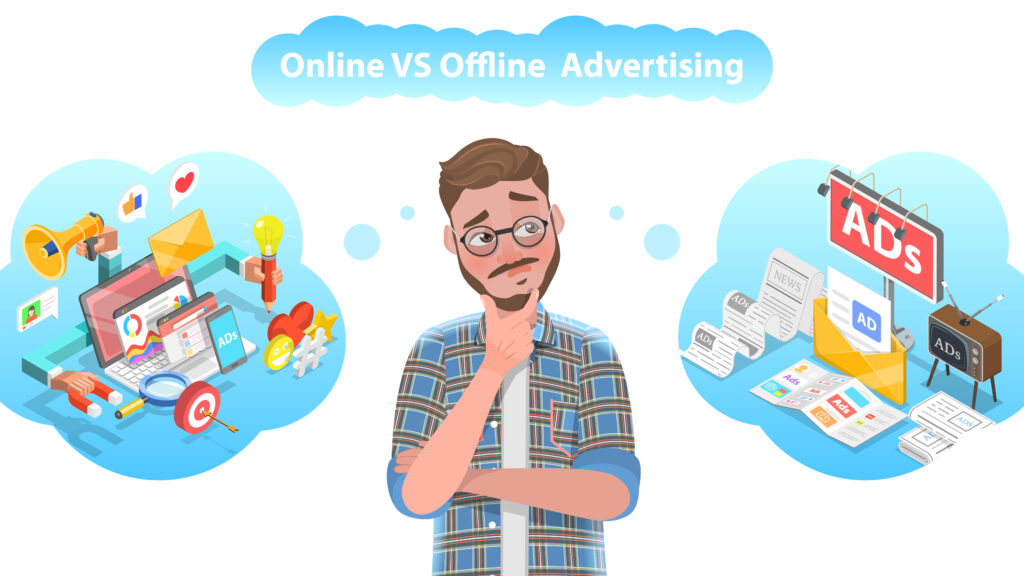
Marketing has changed dramatically over the years. It used to be all about adverts in newspapers or on TV and radio, or flyers posted through letterboxes. Now, it’s SEO (search engine optimisation), TikTok videos, Google ads, and influencers telling you what to buy.
But that doesn’t mean traditional marketing is dead. The best marketing strategies today combine both modern and traditional methods. In this article, we’ll explore the advantages and disadvantages of both approaches, and why a mix of both is best.
Traditional marketing has been around for centuries. The printing press was invented way back in the 1400’s and print advertising was booming by the 19th century. We eventually began to see TV advertising appear on our screens in 1942.
Traditional marketing includes:
• TV and radio adverts
• Print advertising (newspapers, magazines, business cards)
• Direct mail (letters, flyers, brochures, catalogues)
• Outdoor advertising (posters, banners, billboards)
It’s easy for businesses to understand traditional marketing methods and it’s familiar for customers. It especially works for older generations, those without internet access, and local audiences. But there are drawbacks. It can be expensive, harder to track results, and it’s push marketing which inhibits two-way conversation.
When the internet came along, marketing methods changed completely. The first clickable banner appeared in 1993, and by 1998, Google had appeared on the scene. Digital marketing became a way to build relationships and connection with customers.
Digital marketing methods include:
• Social media marketing (Facebook, Instagram, LinkedIn, TikTok)
• Search engine optimisation – both technical and content
• Email marketing (newsletters, promotions, personalised offers)
• Influencer marketing
• PPC (pay per click) advertising (Google, Facebook, YouTube ads)
Many digital marketing methods are free or low cost, making it cost effective for businesses. Ads can be targeted, using people’s interests and browsing behaviour, and real time tracking can identify what’s working. Importantly, customers can engage with businesses.
But there are downsides too. Digital marketing needs technical skills in SEO, analytics and advertising platforms. Plus, social media and Google algorithms are always changing, so you need to stay up to date.
Traditional marketing casts a wide net but it’s not targeted. Digital marketing lets you reach specific audiences based on interests, location, and behaviour.
Traditional marketing can be expensive, which is hard for small businesses. Digital marketing tends to be more affordable. Social media and email marketing is often free, and online ads are cheaper than print.
Traditional marketing is one-way communication. Digital marketing allows direct engagement, so customers can chat, comment, ask questions, and interact with brands.
Traditional marketing relies on intuition and experience. Modern marketing gives real time analytics meaning you can track clicks, views, and conversions. This helps businesses track performance and improve campaigns.
Traditional marketing speaks to everyone. Adverts reach all newspaper readers or TV viewers whether they’re interested or not. Digital marketing allows personalisation, targeting specific customer groups.
Traditional marketing follows a set schedule. Magazines are published on set dates and TV adverts play at a fixed time. Digital marketing is more flexible. Businesses can post content whenever they want and reach customers when they’re online.

Our Business Development Manager Kevin Steel began his career in a very traditional advertising medium, selling space on The Barnsley Chronicle in the early 80’s and then working for its Harrogate based web offset print subsidiary Centrestyle.
He’s seen a remarkable change in technology and marketing channels during the last 40 years, but the one thing he is still advises businesses about is making sure you find the right mix for your marketing and then measuring the impact it’s had.
One of Kevin’s favourite quotes is the classic from Lord Leverhulme, the co-founder of Lever Brothers who once said; ” Half of my advertising is wasted, the trouble is I don’t know which half! ”
Every business is different, so the right approach depends on your needs. To find the right mix, consider:
• Your budget and goals:
Traditional marketing is easier to understand but often more expensive. Digital marketing has a learning curve but is more cost effective.
• Your target audience:
Younger customers respond well to digital marketing, while older audiences may prefer traditional methods.
• Your products / services:
A yoga teacher serving a local area may find traditional adverts work best. A digital brand like web or graphic design will benefit from online strategies where they can show examples their work.
Interestingly, the best strategy is likely to be a blend of both.
Supermarket chain Aldi do this well. They’re well known for the TV adverts at Christmas featuring Kevin the Carrot. But they also have a very strong (and funny) social media presence. They engage with comments and encourage other brands to get involved, reinforcing their own brand.
If you’re used to traditional marketing but want to move into digital, here’s how to start:
Do a marketing audit and look at your current marketing strategies. Decide what’s working well, and what needs an update.
Decide what you want to achieve from your marketing. Do you want to increase brand awareness, find leads, or generate new sales?
Digital marketing needs software and tech skills. Consider email marketing software, social media platforms, and scheduling tools.
Modern marketing is content heavy. Plan what content to create, when to post, and how to distribute it across different channels.
To connect better with your audience, use analytics to learn more about your customers and what they respond to.
Digital marketing allows engagement with people in meaningful ways. Reply to comments, answer questions, and create interactive content.
Real-time analytics can help improve your strategy. Use digital data to track web traffic, CTRs (click through rates), and conversions.
The following ideas can help those looking to combine more modern and traditional marketing methods:
• Attend a local networking meeting and hand out business cards with a QR code linking to your website.
• Advertise on the radio but encourage listeners to follow you on social media.
• Run a print advert but use a unique promotional code to track success.
• Share TV and radio adverts online via social media, YouTube, and podcasts.
• Track event attendance using QR codes and collect email leads.
• Send branded samples to customers via a sign up form on your website.
Using a consistent message across all platforms will strengthen your brand and improve results.
Marketing has evolved over the years, with digital platforms making it easier and more cost effective to reach customers. But traditional marketing methods still have value.
Using both is the secret to success:
• Traditional marketing builds credibility and local awareness, reaching those without internet access.
• Digital marketing helps you stay competitive and reach a wider audience.
• A strong online presence encourages brand engagement and advocacy.
Ultimately though, whether you’re printing flyers or running Facebook ads, great marketing is about one thing – connecting with your customers.
Want to know how The Business Village can help your business be more successful? Get in touch for a chat with our Business Development Manager, Kevin Steel.
Email: ksteel@barnsleybic.co.uk
Phone: 01226 249 590
You may also be interested in reading
How to rebrand your business:
https://www.business-village.co.uk/2025/02/03/how-to-rebrand-your-business/
What is email marketing and how do you get started:
https://www.business-village.co.uk/2023/01/31/what-is-email-marketing-and-how-do-you-get-started/
Get a head start on your marketing with these January strategies:
https://www.business-village.co.uk/2022/12/28/get-a-head-start-on-your-marketing-with-these-january-strategies/